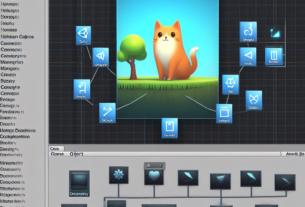
Bring Your Game On: Creating a Mobile Game with Unity
The world of mobile gaming is booming, with millions of players enjoying games on the go. If you’ve ever dreamt of creating your own mobile game, Unity game engine is a fantastic place to start! Unity offers a powerful and user-friendly platform that allows you to build stunning 2D and 3D games for various devices.
This article takes you through the exciting journey of creating a mobile game with Unity, guiding you from the initial concept to building a playable prototype.

Planning Your Mobile Masterpiece:
Before diving into Unity, it’s crucial to solidify your game concept.
- Genre Selection: Will it be a puzzle game, a side-scrolling adventure, or a fast-paced arcade experience? Identify a genre you’re passionate about and that caters to the mobile market.
- Target Audience: Who are you building this game for? Understanding your target demographic will help refine your game’s mechanics, difficulty, and art style.
- Core Gameplay Loop: Define the core gameplay mechanic – the action that keeps players engaged. Is it overcoming obstacles, collecting items, or strategizing against enemies?

Getting Started with Unity:
- Download and Install Unity: Head over to https://unity.com/ to download the latest version of Unity. The free version is perfect for beginners!
- Explore the Interface: Unity offers a clean interface with a scene view, inspector window, and a hierarchy panel. Familiarize yourself with these essential elements.
- Unity Learn Resources: Unity offers a treasure trove of free tutorials and learning materials. Utilize these resources to grasp the fundamentals of building games with Unity.

Building Your Mobile Game in Unity:
- Importing Assets: Unity allows importing various assets like 2D sprites, 3D models, sound effects, and music. You can create your own assets or utilize resources from online asset stores.
- Building the Game Environment: Use Unity’s tools to create your game world. For 2D games, you can place tiles or create backgrounds. In 3D games, build your levels using 3D models and terrain tools.
- Scripting the Gameplay: Unity utilizes C# scripting to define game logic. Start with basic scripting tutorials to learn how to control objects, handle player input, and implement core mechanics.
- Adding Polish: Implement lighting effects, particle systems, and animations to bring your game world to life. Unity offers a visual scripting tool called Bolt that allows you to create complex behaviors without extensive coding knowledge.
- Testing and Iteration: Continuously test your game on a mobile device to identify bugs and refine the gameplay experience. Gather feedback from friends and family to iterate on your design.

Optimizing for Mobile:
- Performance Optimization: Mobile devices have limitations. Focus on optimizing your game’s graphics, code, and memory usage to ensure smooth gameplay.
- Touch Controls: Design intuitive touch controls for your game. Experiment with different layouts and functionalities to find what works best for your specific gameplay.
- Portrait vs. Landscape: Decide whether your game will be played in portrait or landscape mode. Consider how it impacts the gameplay experience and design accordingly.

Taking Your Game to the World:
- Exporting for Mobile: Once your game is polished, use Unity’s built-in tools to export it for specific mobile platforms like Android or iOS.
- App Stores and Distribution: Follow the guidelines for submitting your game to app stores like Google Play Store and Apple App Store. This may involve creating app icons, screenshots, and store descriptions.

Conclusion:
Creating a mobile game with Unity is an exciting and rewarding journey. By following these steps, leveraging Unity’s vast resources, and constantly iterating on your design, you can turn your game concept into a reality and share it with the world!




